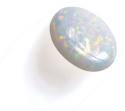October: Opal
October Birthstone: Opal
Birthstone Color: Multi-colored
Opal Myths & Historical Facts
The Opal derives its name from the Latin word "opalus," meaning precious jewel. The opal is prized for its unique ability to refract and reflect specific wavelengths of light, and was called "Cupid Paederos" by the Romans, meaning a child beautiful as love. One legendary explanation for this gemstone's origin is that it fell from heaven in a flash of fiery lightning.
Ancient monarchs treasured Opals, both for their beauty and for their presumed protective powers. They were set into crowns and worn in necklaces to ward off evil and to protect the eyesight. These gemstones were also ground and ingested for their healing properties and to ward off nightmares.
A gift of Opal is symbolic of faithfulness and confidence. And the powerful energy radiating from this fiery gemstone will surely illuminate any occasion!
Alternate Birthstone
An alternate birthstone for October, Pink Tourmaline has the seemingly magical property of pyroelectricity; meaning that when heated, the stone takes on a static electric charge, making it capable of attracting lightweight objects. Pink Tourmaline is considered the "stone of the muse," it was believed to stimulate the creative process of its wearer. Varieties of Pink Tourmaline range in color from pastel pink to ruby red. A gift of this stone is symbolic of hope.
Opal & Tourmaline Facts
Opal dazzles the eye with a spectral display of dancing colors that flash within its mysterious depths. Tourmaline occurs in more colors and color combinations than any other gem variety.
Opals captivate us, mainly because of their unique optical characteristics. Opals often exhibit a spectrum of colors called “play-of-color,” which is observed in various kinds of lighting. The Roman naturalist, Pliny the Elder, referred to opal’s play-of-color in the 1stCentury A.D., when he wrote: “for in them you shall see the living fire of ruby, the glorious purple of the amethyst, the sea-green of the emerald, all glittering together in an incredible mixture of light.”
Opals can have fiery play-of-color, but they can also be colorless, opaque, translucent or transparent.
Opal has a hardness of 5.0-6.5 on the Mohs Hardness Scale. Due to their relative softness, opals are rarely faceted.
Tourmaline is in almost every color of the rainbow. The most popular varieties range from rich reds, pinks and peach colors, to emerald greens and yellows, to blues and violets. Black and brown tourmalines are also used in jewelry. Not surprisingly, this gemstone’s name is derived from the Sinhales word “turmali,” which means “mixed colors.” While it can look like many other materials, tourmaline stands on its own as one of the world’s most popular gems.
Tourmaline Facts
-Brazil is one of the world’s main sources of tourmaline. Others include Afghanistan, Kenya, Madagascar, Mozambique, Namibia, Pakistan, Russia, Sri Lanka, Tanzania, the United States and Zambia.
-Tourmaline is a durable gemstone with a hardness of 7.0-7.5 on the Mohs Hardness Scale.
-Tourmaline can be cut in many shapes and sizes, often as faceted gems, cabachons, polished crystal slices or mineral specimens. Cutters often fashion tourmalines as long rectangles.
-“Parti-colored” tourmalines exhibits two or more colors in a single gem, such as watermelon and liddicoatite tourmalines. “bi-color” tourmaline displays two distinct color zones. Paraiba tourmaline, named after the place where it was first found in Brazil, is a trade term for vividly saturated green to blue or violet copper-beating elbaite tourmaline. Rubellite refers to vivid pink to red elbaite tourmaline. Indicolite refers to the blue variety. Chrome tourmaline is a trade term for vibrant green tourmaline.
Tourmaline Treatment
Many green and blue tourmalines are heated. Many near-colorless or pale gems are irradiated. Cat’s eyes are occasionally treated with acid, then filled. Information about any stone known to be treated should be disclosed to the buyer.
Tourmaline care and cleaning
-To minimize scratching and wear, store each piece of fine jewelry separately in a soft cloth or padded container.
-Exposure to high heat is not recommended. Strong heat may alter color and sudden temperature changes may cause fracturing.
-Tourmaline jewelry is best cleaned with warm, sudsy water and a tightly woven microfiber or other soft cloth.
-Take all your fine jewelry to a professional jeweler at least twice a year for a thorough cleaning and inspection.

